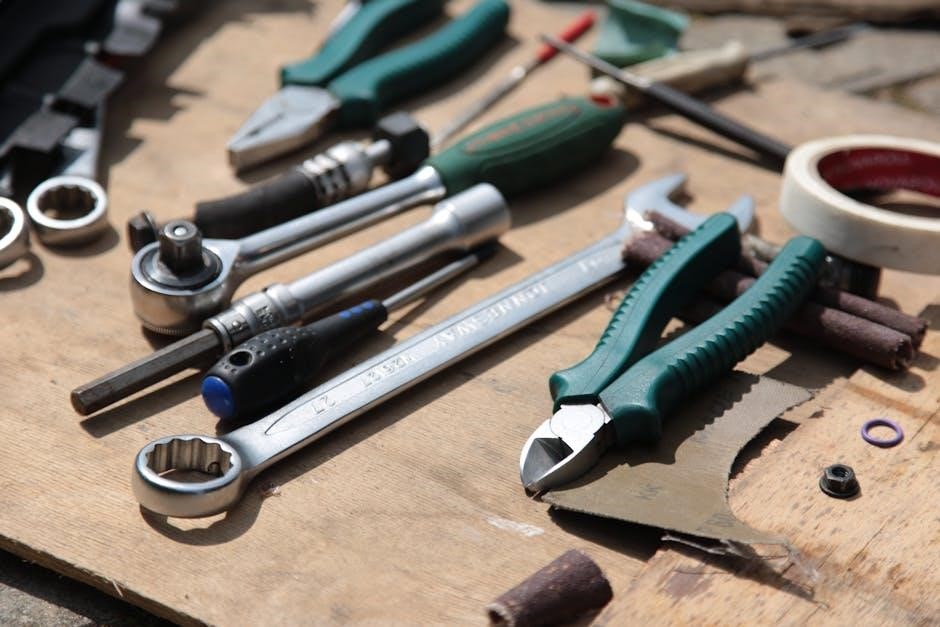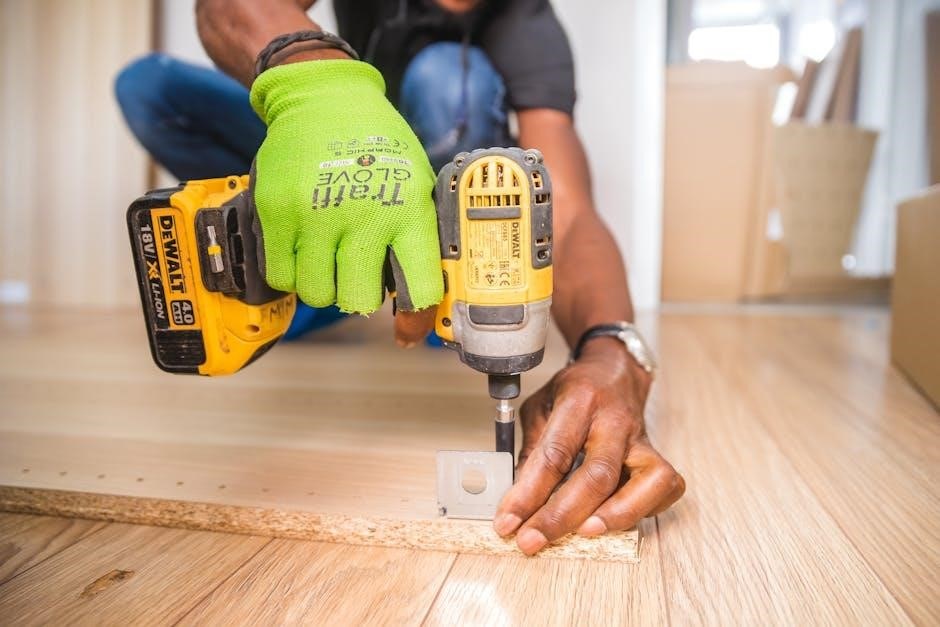The AR-15 platform is a highly customizable and versatile rifle, known for its modular design and widespread popularity. This guide provides a detailed introduction to understanding its components, assembly, and functionality, making it an essential resource for both novice and experienced gun enthusiasts.
1.1 Overview of the AR-15 Rifle
The AR-15 is a semi-automatic rifle renowned for its modular design, adaptability, and reliability. It consists of two main components: the upper receiver, which houses the barrel, gas system, and bolt carrier group, and the lower receiver, containing the trigger, magazine, and stock. This separation allows for easy customization and maintenance. Its lightweight construction and ergonomic design make it popular among shooters of all skill levels. The rifle’s versatility enables it to be configured for various purposes, from recreational shooting to tactical use. Understanding its components and assembly is key to proper function and safety, as detailed in this guide.
1.2 Importance of Understanding the Assembly Process
Understanding the AR-15 assembly process is crucial for responsible ownership and customization. Proper assembly ensures reliability, safety, and optimal performance. Misassembly can lead to malfunctions or safety hazards, making knowledge of correct procedures essential. This guide provides detailed instructions to help builders navigate the process confidently. By mastering assembly, enthusiasts can personalize their rifles to meet specific needs, enhance functionality, and maintain their firearms effectively. Knowledge of assembly also fosters a deeper appreciation for the rifle’s design and operation, empowering owners to make informed decisions and troubleshoot issues efficiently. This comprehensive understanding is vital for both novice builders and experienced gunsmiths alike.
1.3 Brief History and Evolution of the AR-15
The AR-15, developed in the 1950s by ArmaLite, was designed as a lightweight, high-velocity rifle for military use. Adopted as the M16, it became iconic for its reliability and modularity. Over decades, the platform evolved, transitioning from military to civilian markets, where it gained popularity for its versatility. Today, the AR-15 is a cornerstone of modern firearms, with countless configurations for hunting, sport shooting, and self-defense. Its adaptability and the introduction of new materials have kept it relevant, making it a timeless symbol of innovation in firearms design. This evolution underscores its enduring appeal and practicality.

Safety Precautions and Best Practices
Always handle firearms safely, ensuring the rifle is unloaded and pointed in a safe direction. Use eye and ear protection, and maintain a clean, distraction-free workspace. Never alter the firearm without proper knowledge, and follow all local laws and regulations. Regularly inspect and maintain the rifle to ensure reliability and performance. Keep firearms out of reach of children and unauthorized individuals. Proper safety practices are essential for responsible ownership and operation of the AR-15 platform.
2.1 Fundamental Safety Rules for Firearms Assembly
When assembling an AR-15, always treat the firearm as if it were loaded, ensuring the muzzle is pointed in a safe direction. Keep your finger off the trigger until ready to shoot. Wear safety glasses and ear protection to protect against debris and noise. Use a clean, well-lit workspace free from distractions. Never modify or alter the firearm without proper knowledge or guidance. Always follow the manufacturer’s instructions and ensure all components are compatible. Regularly inspect the rifle for wear or damage, and store it unloaded when not in use. Proper safety practices prevent accidents and ensure a secure environment for assembly.
2.2 Setting Up a Safe Workspace
A safe workspace is critical for assembling an AR-15. Ensure the area is clean, well-lit, and free from distractions. Use a sturdy workbench or table with a gunsmithing mat to prevent parts from rolling away. Proper ventilation is essential to avoid inhaling cleaning solvents or lubricants. Keep tools and components organized to maintain efficiency and reduce the risk of losing small parts. Ensure all firearms are unloaded and pointed in a safe direction. Keep children and pets away from the workspace. Having a well-prepared workspace minimizes risks and ensures a smooth assembly process.
2.3 Essential Safety Gear (Eye and Ear Protection)
Protecting yourself with proper safety gear is vital when assembling an AR-15; Always wear safety glasses or goggles to shield your eyes from debris, springs, or other small parts that may fly loose. Ear protection, such as earplugs or earmuffs, is equally important to safeguard against the loud noises generated during assembly and testing. These precautions ensure a safe working environment and prevent potential injuries. Additionally, a gunsmithing mat can help keep tools and parts organized, reducing the risk of losing components. Prioritizing safety gear creates a responsible and secure workspace for assembling your AR-15.
2.4 Handling Firearms Responsibly
Responsible firearm handling is crucial during the assembly and use of an AR-15. Always treat the rifle as if it is loaded, ensuring the muzzle is pointed in a safe direction away from people and objects. Avoid unnecessary modifications without proper expertise, as this can compromise safety and functionality. Never point the firearm at anything you do not intend to shoot. Following these guidelines ensures a secure environment for assembly and operation, promoting safe practices and preventing accidents. This approach fosters confidence and respect for the firearm, essential for both novices and experienced enthusiasts.

Tools and Materials Required
Building an AR-15 requires specialized tools like a torque wrench, punch set, and vise block, along with materials such as a lower receiver, barrel, and bolt carrier group. High-quality components ensure reliability and safety, emphasizing compatibility and proper fitment for optimal performance.
3.1 List of Specialized Tools Needed
Assembling an AR-15 requires specific tools to ensure accuracy and safety. A torque wrench is essential for securing barrel nuts and castle nuts to precise specifications. A punch set helps install and remove pins in the lower receiver, while a vise block stabilizes the upper receiver during assembly. Additional tools include an armorer’s wrench for adjusting the gas system and a muzzle device wrench for installing flash suppressors or compensators. A gunsmithing mat protects parts from damage and prevents tools from rolling away. High-quality tools are critical to ensure proper fitment and functionality, avoiding potential issues during assembly and firing.
3.2 Recommended Hand Tools for Assembly
Essential hand tools for assembling your AR-15 include a set of screwdrivers (flathead and Phillips), needle-nose pliers for small parts, and a punch set for installing pins. A torque wrench is crucial for securing barrel nuts and castle nuts. Additionally, a vise block or upper receiver block helps stabilize the upper receiver during assembly. A cleaning brush and solvent are necessary for preparing parts. A high-quality screwdriver set ensures proper fitment for triggers and safety selectors. Having these tools on hand streamlines the assembly process, reducing frustration and ensuring a secure, functional build. Quality tools are vital for precision and safety.
3.3 Materials and Components Overview
The AR-15 assembly requires a variety of materials and components, including the lower and upper receivers, barrel, bolt carrier group, and gas system. Key materials include aluminum for receivers and steel for critical parts like barrels and bolts. Components such as triggers, stocks, and grips enhance functionality and ergonomics. The lower receiver houses the fire control group, while the upper receiver accommodates the barrel and gas system. High-quality materials ensure durability and reliability. Proper compatibility between components is essential for smooth operation. Ensuring all parts meet industry standards is crucial for a safe and functional firearm. Careful selection of materials and components is vital for optimal performance.
3.4 Importance of High-Quality Components
Using high-quality components is critical for ensuring the reliability, safety, and performance of an AR-15. Inferior parts can lead to malfunctions, safety hazards, and reduced accuracy. Key components like the barrel, bolt carrier group, and lower receiver must be made from durable materials, such as high-grade steel or aircraft aluminum, to withstand the stresses of firing. Proper heat treatment and manufacturing processes ensure long-term reliability. Additionally, components from reputable manufacturers guarantee compatibility and adherence to industry standards. Investing in quality parts not only enhances performance but also ensures a safer and more enjoyable shooting experience. Prioritizing high-quality components is essential for a reliable AR-15 build.

Lower Receiver Assembly
The lower receiver assembly forms the foundation of the AR-15, housing critical components like the trigger, hammer, and safety selector. Proper installation ensures reliability and safety.
4.1 Installing the Lower Parts Kit
Installing the lower parts kit is a critical step in assembling the AR-15. This kit includes essential components such as the trigger, hammer, safety selector, magazine release, and grip. Begin by ensuring all parts are compatible and properly organized. Start with the trigger assembly, carefully seating it into the lower receiver and securing it with the provided pins. Next, install the hammer and safety selector, ensuring smooth operation and proper alignment. The magazine release and grip follow, with precise torque specifications for secure fastening. Use a punch set and torque wrench for accuracy. Proper installation ensures reliable function and safety.

4.2 Buffer Tube and Buffer Installation
Installing the buffer tube and buffer is essential for the AR-15’s functionality. The buffer tube houses the buffer spring and buffer, which absorb recoil and reduce stress on the firearm. Begin by threading the buffer tube into the lower receiver, ensuring it is securely seated. Use a torque wrench to tighten the castle nut, following the manufacturer’s torque specifications to prevent loosening. Next, insert the buffer into the buffer tube, ensuring it is properly seated and the spring is compressed correctly. Finally, install the end plate and ensure all components are aligned and secure. Proper installation guarantees smooth operation and reliability.
4.3 Stock Installation and Adjustment
Proper stock installation and adjustment are crucial for both functionality and shooter comfort. Begin by attaching the stock to the buffer tube, ensuring it is securely fastened using the castle nut. Tighten the castle nut with a torque wrench to the manufacturer’s specifications to prevent loosening during use. Once installed, adjust the stock’s length to fit your shooting position, ensuring a comfortable and consistent cheek weld. Most stocks feature a quick-detach mechanism or telescoping design, allowing for easy customization. After adjustment, test the stock’s stability by cycling the rifle to ensure it remains secure. Proper fitment enhances accuracy and control.
4.4 Final Assembly Checks for the Lower Receiver
After completing the lower receiver assembly, perform a thorough inspection to ensure all components are properly installed and functioning correctly. Check the trigger mechanism for a smooth, consistent pull and verify the safety selector operates seamlessly between safe and fire modes. Ensure the buffer tube is securely fastened with the castle nut and end plate, and the stock is properly aligned and adjusted. Tighten all screws to the manufacturer’s torque specifications to prevent loosening. Finally, cycle the action to confirm smooth operation and test the magazine release function. These checks ensure reliability, safety, and optimal performance of the lower receiver assembly.

Upper Receiver Assembly
The upper receiver assembly involves installing the barrel, gas system, and bolt carrier group. Proper alignment and secure fastening ensure accuracy and reliable cycling of the rifle.
5.1 Barrel Installation and Alignment
Barrel installation is a critical step in the upper receiver assembly, requiring precision to ensure accuracy and reliability. Start by aligning the barrel with the upper receiver, ensuring it is properly seated. Use a torque wrench to tighten the barrel nut to the manufacturer’s specified torque setting, typically between 30-80 ft-lbs, depending on the barrel nut type. A crush washer or barrel nut spacer may be required for proper alignment. Once secured, verify the barrel’s alignment with the gas system and bolt carrier group to ensure smooth cycling. Proper installation prevents accuracy issues and potential damage to the rifle. Always follow the manufacturer’s instructions for specific barrel and receiver combinations, and consider using a barrel nut wrench for added leverage. Finally, lubricate the barrel nut threads before tightening to prevent galling and ensure a secure fit. This step is crucial for the rifle’s overall performance and longevity.
5.2 Gas System Installation and Setup
Installing the gas system is essential for the AR-15’s reliable operation. Begin by selecting the appropriate gas tube length to match your barrel length. Insert the gas tube into the upper receiver, ensuring it aligns with the gas port on the barrel. Secure the gas block with a gas block alignment tool, tightening it firmly to prevent movement. Attach the gas tube to the gas block using the provided hardware, ensuring a snug fit. Proper alignment and tightness are critical to prevent gas leaks and ensure consistent cycling. After installation, test the system by cycling the bolt carrier group to confirm smooth operation. Always refer to the manufacturer’s specifications for torque values and assembly instructions to ensure a reliable and functional gas system.
5.3 Bolt Carrier Group Installation
Installing the bolt carrier group (BCG) is crucial for the AR-15’s functioning. Begin by ensuring the BCG is clean and properly lubricated. Align the BCG with the upper receiver’s rails, gently sliding it into place. Ensure the gas key on the BCG aligns with the gas tube. Secure the BCG by tightening the gas tube retaining screws evenly. Avoid over-tightening, as this can damage the gas key. Once installed, cycle the bolt carrier group several times to ensure smooth operation. Proper installation ensures reliable cycling and consistent performance. Always refer to the manufacturer’s instructions for specific torque specifications and alignment details.
5.4 Muzzle Device Installation
Installing a muzzle device requires precision to ensure proper function and safety. Begin by threading the device onto the barrel, aligning it with the barrel’s threads. Use a muzzle device wrench to securely tighten the device, following the manufacturer’s torque specifications. Ensure the device is properly seated to prevent loosening during use. The muzzle device serves to manage flash, reduce recoil, or compensate for muzzle rise. After installation, inspect the device for proper alignment and secureness. Always wear eye protection during this process. A correctly installed muzzle device enhances the rifle’s performance and reliability, ensuring optimal functionality during firing.
5.5 Final Checks for the Upper Receiver
After assembling the upper receiver, perform a thorough inspection to ensure all components are securely installed and properly aligned. Check the barrel for correct installation and alignment with the upper receiver. Verify the gas system is correctly assembled and functioning as intended; Ensure the bolt carrier group is installed and cycles smoothly. Inspect the muzzle device for proper installation and alignment. Use a torque wrench to confirm all fasteners meet the manufacturer’s torque specifications. Perform a test cycle with an empty magazine to ensure proper function. Finally, clean and lubricate all moving parts to ensure reliability and optimal performance.

Combining the Upper and Lower Receivers
Align the upper and lower receivers by their pivot and takedown pins, ensuring a snug and secure fit. Use a pin punch to finalize the attachment, ensuring proper function and alignment for reliable operation.
6.1 Aligning and Attaching the Upper and Lower
Align the upper and lower receivers by their pivot and takedown pins, ensuring a snug and secure fit. Use a punch to gently push the pins into place, verifying proper alignment. Once aligned, the receivers should lock together seamlessly. Check for any play or misalignment, as this can affect functionality. Ensure the charging handle moves smoothly and the dust cover operates correctly. Secure the receivers by tightening the pivot pin screw if your rifle is equipped with one. Proper alignment and attachment are critical for ensuring reliable operation and maintaining the structural integrity of the rifle.
6.2 Ensuring Proper Function and Fit
After attaching the upper and lower receivers, ensure all components function seamlessly. Check the charging handle for smooth operation and verify the dust cover cycles properly. Test the magazine fit in the mag well, ensuring it seats securely without wobbling. The safety selector should move freely between safe and fire positions. Inspect the overall fit for any play or misalignment, as improper fit can lead to malfunctions. Perform a series of dry firing exercises to ensure the rifle cycles correctly. Proper function and fit are critical for reliability and performance, confirming the rifle is ready for final testing and use.

Initial Testing and Troubleshooting
Conduct a thorough function test of the complete rifle to identify and address any issues. Check for proper cycling, feeding, and ejecting of rounds. Common problems like failure to fire or eject can often be traced to gas system issues or magazine fit. Apply proven solutions such as adjusting the gas block or replacing faulty components. Ensure all parts are lubricated and properly aligned. This step ensures reliability and performance, confirming the rifle is ready for safe and effective use.
7.1 Function Testing the Complete Rifle
After assembling the AR-15, conduct a thorough function test to ensure all components work seamlessly. Begin by chambering a round and firing to check for proper cycling, feeding, and ejecting. Verify the upper and lower receivers are securely aligned and function as a unit. Test the gas system by firing multiple rounds to ensure consistent operation. Inspect the bolt carrier group for smooth movement and proper locking. Check the muzzle device for secure attachment and function. Ensure the trigger resets correctly and the safety operates smoothly. Address any malfunctions promptly, as failure to do so may lead to reliability issues. Proper function testing confirms the rifle is ready for safe and effective use.
7.2 Common Issues and Solutions
Common issues during AR-15 assembly include failure to cycle, feeding problems, or ejecting inconsistencies. These often stem from improper gas system installation or misaligned components. To resolve cycling issues, ensure the gas block is securely attached and the gas tube is properly aligned. For feeding problems, check magazine alignment and ensure the bolt carrier group is clean and well-lubricated. Ejection issues may result from an improperly installed ejector or incorrect gas port sizing. Address these by inspecting the ejector for proper seating and verifying gas port specifications. Regular maintenance, such as cleaning and lubrication, can prevent many of these issues. Always refer to the guide for precise solutions to ensure reliable firearm operation.

Maintenance and Cleaning
Regular maintenance is crucial for the AR-15’s longevity and reliability. Cleaning the barrel, bolt carrier group, and lubricating moving parts ensures optimal performance and prevents malfunctions.
8.1 Routine Cleaning Procedures
Routine cleaning is essential for maintaining the AR-15’s performance and longevity. Start by field-stripping the rifle to access key components. Use a cleaning rod and brush to remove fouling from the barrel, chamber, and gas system. Wipe down the bolt carrier group with a solvent-dampened cloth, paying attention to the bolt face and firing pin. Lubricate moving parts with a high-quality gun oil. Clean the upper and lower receivers separately, ensuring no debris remains. Reassemble the rifle and inspect for proper function. Regular cleaning prevents corrosion and ensures reliable operation. Always use proper cleaning tools and materials for optimal results.
8.2 Lubrication and Maintenance Tips
Proper lubrication is crucial for the AR-15’s smooth operation. Apply high-quality gun oil to moving parts like the bolt carrier group, trigger components, and gas system. Avoid over-lubrication, as it can attract debris. Regularly inspect and clean the rifle to prevent corrosion. Store the AR-15 in a dry environment, and consider using a silica gel packet to absorb moisture. Replace worn-out parts promptly to maintain reliability. Lubricate after cleaning or exposure to harsh conditions. Use a microfiber cloth to wipe down surfaces, ensuring a clean finish. These maintenance tips ensure optimal performance and extend the rifle’s lifespan. Consistency is key to preserving your AR-15.

Accessories and Customization
Accessorizing and customizing the AR-15 enhances performance and personalization. Optics, scopes, and tactical gear can be added to suit specific needs, while personalized touches optimize functionality and aesthetics.
9.1 Choosing the Right Optics and Scopes
Selecting the right optics and scopes for your AR-15 is crucial for accuracy and performance. Magnified scopes are ideal for long-range shooting, while red dot sights offer quick target acquisition. Reflex sights provide versatility, and holographic sights excel in low-light conditions. Consider your shooting environment, target distance, and personal preference when choosing optics. Ensure compatibility with your rifle’s rail system and mounting hardware. Proper installation and zeroing are essential for optimal accuracy. High-quality optics enhance your shooting experience, whether for competition, hunting, or tactical use, making them a valuable addition to your AR-15 setup.
9.2 Adding Tactical Accessories
Addition of tactical accessories enhances the functionality and performance of your AR-15, tailoring it to specific needs. Popular options include tactical grips, flashlights, lasers, and slings, improving control and versatility. Rail systems provide mounting points for optics, lights, and other attachments. Magazine pouches and plate carriers increase tactical readiness. Accessories like muzzle devices and suppressors can reduce recoil and noise. Each addition should align with the rifle’s intended use, whether for competition, hunting, or self-defense. Proper installation and compatibility ensure optimal performance, making tactical accessories a key part of customizing your AR-15 for enhanced effectiveness in various scenarios.
9.3 Personalizing the Rifle for Optimal Performance
Personalizing your AR-15 ensures it meets your specific needs and shooting style. Ergonomic upgrades, such as adjustable stocks and grips, enhance comfort and control. Upgrading the trigger system improves accuracy and responsiveness. Customizing the barrel length and profile can optimize accuracy and reduce weight. Accessories like scopes, red dot sights, and magnifiers enhance targeting precision. Adding a compensator or muzzle brake reduces recoil, improving follow-up shots. Each modification should be carefully considered to maintain balance and functionality. By tailoring the rifle to your preferences, you achieve optimal performance, whether for competition, hunting, or self-defense, ensuring a seamless and reliable shooting experience.
The AR-15 Complete Assembly Guide PDF empowers owners with detailed instructions and safety tips, fostering confidence in building and maintaining their rifle. Continuous learning and practice ensure mastery of the platform.
10.1 Summary of the Assembly Process
The AR-15 Complete Assembly Guide PDF provides a comprehensive overview of the assembly process, from the lower receiver to the upper receiver. It details installing the lower parts kit, buffer tube, and stock, followed by the upper receiver’s barrel, gas system, and bolt carrier group. The guide emphasizes safety, proper tool usage, and high-quality components. It also covers final assembly checks, ensuring all parts function seamlessly. By following the guide, builders gain hands-on experience and a deeper understanding of the AR-15 platform, culminating in a fully functional and personalized rifle. This resource is invaluable for both novices and experienced enthusiasts alike.
10.2 Encouragement for Further Learning
Building an AR-15 is a rewarding experience that fosters a deeper understanding of firearms mechanics and maintenance. This guide serves as a foundation, but there’s always more to explore. Encourage yourself to delve into advanced customization, explore new accessories, and experiment with upgrades to tailor your rifle to your needs. Continuous learning enhances your skills and appreciation for the platform. Join online forums, attend workshops, and seek hands-on practice to refine your expertise. Embrace the journey of discovery and growth, ensuring your AR-15 remains a reliable and personalized tool for years to come.